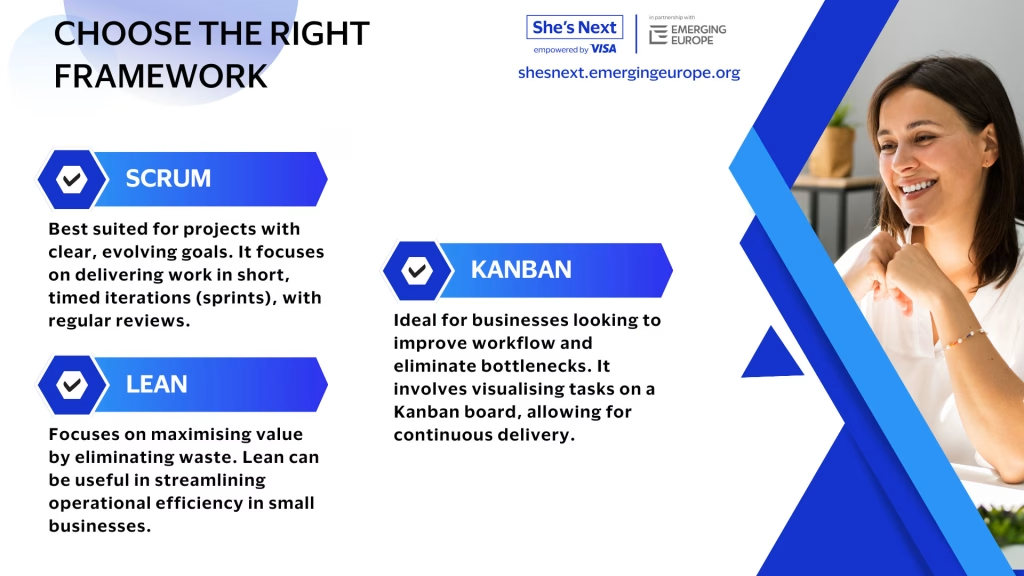
How to Implement Agile Methodology in Your Business
In the previous article we explored the basics of Agile. Here, we will look at implementing the methodology to give your organisation the flexibility and responsiveness needed to stay competitive.
Form an Agile Team
The foundation of a successful Agile implementation is a cross-functional team. Agile teams are small, self-organising groups that work together to deliver project goals efficiently. Each member brings a unique skillset to the table, enabling the team to be versatile and adaptive.
Key Roles to Fill
Product Owner: This person acts as the voice of the customer, ensuring that the team delivers what the customer truly needs.
Scrum Master: The Scrum Master is responsible for guiding the team through Agile practices, removing roadblocks, and facilitating collaboration.
Developers/Team Members: These are the people who actually work on the tasks, whether they are developers, designers, or other specialists depending on the project.
Begin by identifying individuals within your organisation who can fill these key roles. For small businesses, one person might have to wear multiple hats, which can still work in an Agile setup, as long as roles are clearly defined.
Choose the Right Framework
There are several Agile frameworks, each offering its own advantages depending on your business needs. The most common ones include:
Scrum: Best suited for projects with clear, evolving goals. It focuses on delivering work in short, timed iterations (sprints), with regular reviews.
Kanban: Ideal for businesses looking to improve workflow and eliminate bottlenecks. It involves visualising tasks on a Kanban board, allowing for continuous delivery.
Lean: Primarily focuses on maximising value by eliminating waste. Lean can be particularly useful in streamlining operational efficiency in small businesses.
Assess which framework aligns with your business model. For example, if your company handles ongoing customer support or operates in manufacturing, Kanban may be ideal for visualising workflows and continuous delivery. On the other hand, Scrum might suit a software development company working on time-bound projects, where iterative delivery is critical.
Implement Agile Tools
Agile relies heavily on tools that help teams collaborate, track progress, and stay aligned with project goals. There are numerous Agile project management tools available that can help your team stay organised and transparent.
Choose a tool that suits your team’s size. If you’re a small design agency, Trello can be an easy way to manage client projects with a visual task board. For more complex projects, such as app development, Jira might offer more detailed features, including sprint tracking and bug tracking.

Start with Small Iterations (Sprints)
One of the core aspects of Agile is breaking down large projects into smaller, manageable cycles, known as sprints. Each sprint focuses on completing a set of tasks within a time-boxed period, typically 2 to 4 weeks. This allows teams to review progress regularly and make adjustments before moving forward.
Start by running a sprint planning meeting. In this meeting, set clear, achievable goals for the sprint and define what success looks like at the end of the cycle.
Conduct Regular Reviews and Retrospectives
At the end of each sprint, hold a sprint review to evaluate what’s been achieved and gather feedback. Additionally, conduct a retrospective to reflect on how the team worked together, what went well, and what could be improved in the next sprint.
Make these meetings a habit. For small teams, these reviews don’t need to be long, but they should happen consistently. By regularly assessing your process, you can identify areas of improvement and ensure that the team is continually optimising performance.
Foster a Culture of Collaboration
Agile is all about open communication, transparency, and teamwork. A successful Agile implementation isn’t just about adopting tools and processes but also about cultivating the right mindset.
Establish daily stand-up meetings (often referred to as daily Scrums) where team members briefly update each other on progress, challenges, and next steps. This helps ensure that everyone stays on the same page and can address issues immediately.
By implementing Agile methodology, your business can become more flexible, collaborative, and responsive to customer needs.
Whether you start small with a single team or roll out Agile across the entire organisation, the benefits of Agile—faster time to market, increased customer satisfaction, and continuous improvement—are well worth the investment.
New Free Courses — Made for Ambitious Women Entrepreneurs!
It’s time to grow smarter, adapt faster, and take your business global.
Explore two powerful courses available exclusively to She’s Next members:
The Reinvention Masterclass for Start-up Founders
Beyond Borders: Building for Global Success
Enroll today — it’s free!





